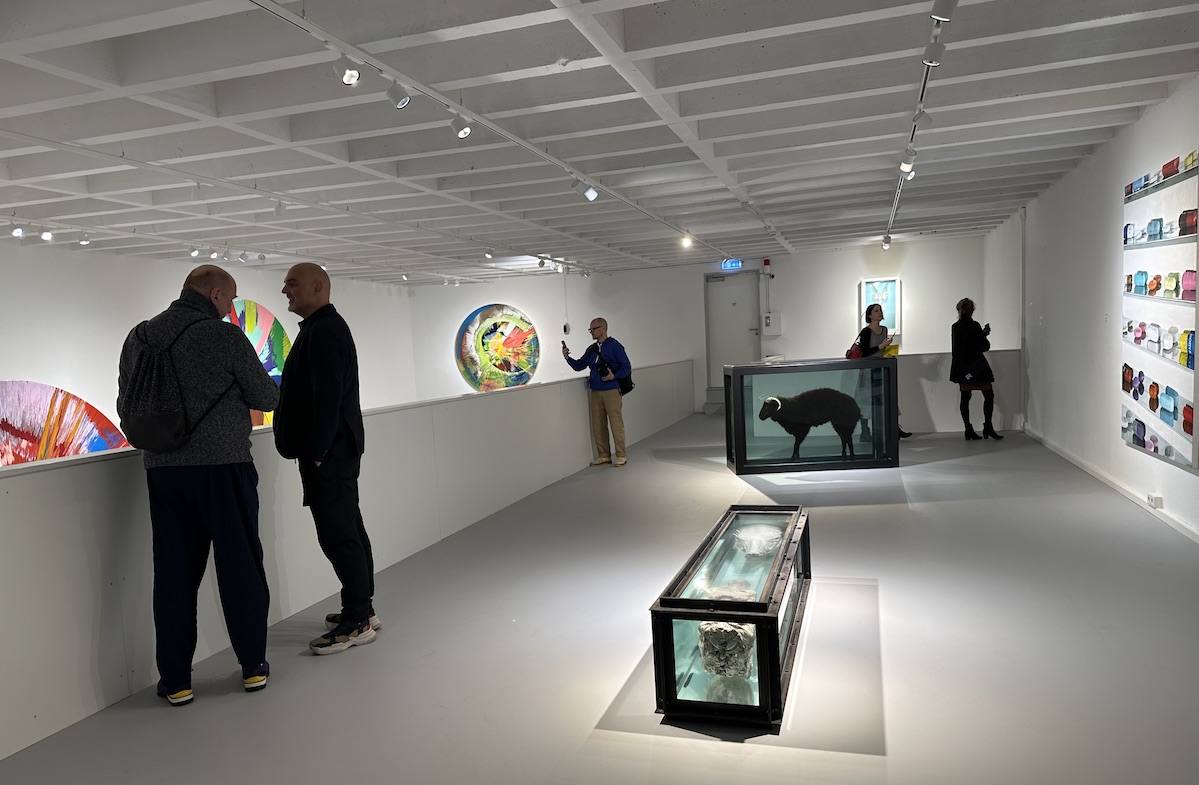Damien Hirst, the Turner Prize-winning British artist best known for his bold concepts and provocative artworks, has unveiled his first retrospective exhibition in Germany at the Museum of Urban and Contemporary Art (MUCA) Munich.
The museum is the brainchild of Christian and Stephanie Utz, a collecting power couple who have been trendsetters for over two decades. The gallery is located in a disused sub-power station in the heart of Munich. This private museum displays Utz’s collection and offers a broad programme of exhibitions and talks and houses one of the only Michelin Star restaurants in Munich.
The Hirst exhibition came about by a chance meeting with the artist, a personal friend. Utz put out a few feelers and got the response he hoped for, “If you don’t ask, you won’t get”, and this worked out well with the artist lending over 40 works covering his career from the early 90s onward.

The exhibition reveals Hirst’s complex relationship with Art and Science and opens a portal into Hirst’s creative universe, spanning decades of artistic development. From his iconic series of preserved animals in formaldehyde, challenging the boundaries of life and death, to his Spot Paintings that transform the canvas into flickerings of colour and geometry, the retrospective encapsulates the full spectrum of Hirst’s ingenuity.
Myth Explored, Explained, Exploded, 1993 greets visitors entering the museum. It is a seminal work featuring a preserved shark suspended in a tank of formaldehyde. This piece, emblematic of Hirst’s audacity, is a visceral introduction to his exploration of mortality and the human psyche.
The high walls in the main room of the gallery are hung with Hirst’s “Spin Paintings”, a clever take on a popular fairground attraction. Some are spinning…some are static. There are examples of all phases of Hirst’s career here, including Medicine Cabinets, pieces from his Venice show, ‘Treasures from the Wreck of the Unbelievable’, Cherry Blossom paintings (not a personal favourite), plus Spot and Butterfly paintings.

One of the biggest surprises is that MUCA has managed to secure “For The Love Of God” 2007, Hirst’s diamond-encrusted platinum scull. I first saw this at Tate Modern in 2012, and it hasn’t been exhibited since. This elusive Artwork is securely tucked away in a WW2 bunker beneath the gallery, adding to its myth. I asked Christian about security and insurance, “It was a nightmare of logistics, and not only is the piece attended to by two full-time security staff, but it is under thick bulletproof glass”, not one for the amature light-fingered Jewell thief. The Artwork is insured for £100,000,000. Let’s hope the museum doesn’t have a repetition of Maurizio Cattelan’s “America”, the £4.5m 18k gold toilet stolen from Blenheim Palace in 2019.
Hirst’s art has always thrived on stirring controversy and questioning societal norms. One cannot ignore the visceral impact of his series of medicine cabinet installations, each compartment meticulously stocked with pharmaceuticals. These artworks delve into society’s complex relationship with pharma meds, simultaneously unsettling and inviting introspection. This has become even more relevant today due to the Sackler-created Opioid crisis that has killed over a million people worldwide.
The Munich survey exhibition showcases Hirst’s ability to blend provocation with visual contemplation seamlessly, prompting viewers to ponder the fusion of medicine and art. It challenges preconceived notions and invites discourse on the commodification of healthcare and the human body.

As visitors progress into the exhibition, they are confronted by a sculpture utilising an inflatable beach ball. ‘The Fragility of Love’ 2000 depicts a hovering ball over a pool of knife-blades. Hirst’s fascination with visual puns excels in this work.
Christian Utz has also commissioned a massive ‘Spot’ mural on the back wall of the power station. It is visible from the top of Munich’s main cathedral. Theory and geometric precision show each spot is seemingly uniform from afar, revealing subtle nuances upon closer inspection, that engages the observer in a mesmerising dance of hues.
While Hirst’s visual aesthetics are undeniably clever, the survey exhibition delves beyond the surface, inviting viewers to explore the conceptual depth underlying his art. One cannot ignore the immersive ‘Treasures from the Wreck of the Unbelievable.’ The bronze self-portrait displayed looks like a statue of the Emperor Nero, juxtaposed with a barnacle-encrusted portrait of Mickey Mouse, which references the world of Jacques Cousteau a television series that inspired the works. Although these key pieces looked different in Venice you still can imagine the context and the sculpture on its own is remarkable.
Central to Hirst’s practice is the dialogue he fosters with his audience. His provocative pieces, ranging from vitrines to diamond and fly-encrusted skulls, challenge viewers to confront their fears, desires, and perceptions. The survey exhibition amplifies this dialogue, encouraging visitors to engage critically with the art, sparking conversations that transcend the confines of the gallery walls.
Christian and Stephanie Utz have lived in both New York and London. Munich-born they have come home to stand as critical figures in Munich’s burgeoning art scene. MUCA, under Utz’s guidance, has become a hub for urban and contemporary art enthusiasts. Its mission is clear: to provide a platform for artists working in non-traditional mediums, such as street art and graffiti. Utz’s vision is to break down the barriers between conventional art spaces and the vibrant, dynamic art forms that often exist on the streets.
Words/Photos: Photo: P C Robinson © Artlyst 2023
Experience this exhibition. It won’t disappoint!
Damien Hirst ‘The Weight of Things’ Museum of Urban and Contemporary Art (MUCA) Munich, From 26 October 2023

